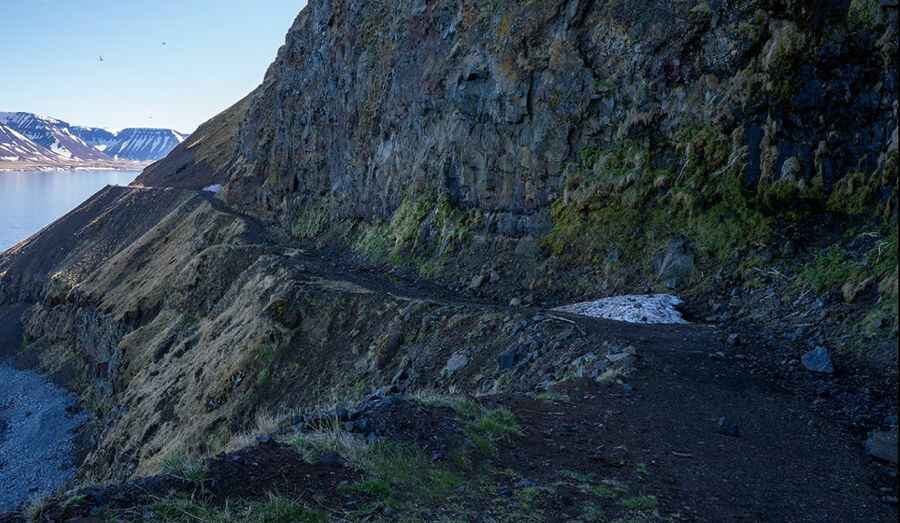Road 622 is a hazardous drive below sea level when the tide is high
Road 622 is considered one of the most challenging drives on Earth. Located on the coast of the Dýrafjörður fjord in the Westfjords of Iceland, some describe it as the most terrifying road in the country. It is an incredibly beautiful route, with the road carved into and under cliffs, offering stunning mountain views throughout. If you have a Jeep, 4x4 experience, time, and strong nerves, driving this road is possible.

How long is Road 622 in Iceland?
Road 622, also known as Svalvogur Road, is entirely unpaved. It spans 51.0 km (31.68 miles), running from Þingeyri to Hrafnseyri, passing through the Dýrafjördur and Arnarfjördur fjords in the mountainous Westfjords peninsula. To drive on this road, a 4x4 with high ground clearance is necessary. It's a loose rocky track and sometimes muddy. Expect rough gravel, and even mud, and go on low tide on the south part of it. A significant portion of it is also below sea level when the tide is high. Despite its challenges, the road surprisingly does not carry an "F" label, yet it is a genuinely good 4x4 track.
How long does it take to drive Road 622 in Iceland?
Driving this picturesque road without stopping typically takes between 2 and 3 hours. It provides access to a small cove called Svalvogar. In the middle of the road, don't forget to visit the Svalvogaviti lighthouse, built-in 1920.
Is Road 622 in Iceland worth it?
Situated on the northwestern part of the country, the road offers sweeping views of the Northwestern Icelandic coastline. Locals refer to it as the Dream Road due to its incredible scenery. It's an insanely beautiful route, with the road carved into and under cliffs, providing magnificent mountain views all the way. The road showcases a spectacularly scenic shoreline on one side and a breathtaking mountain range, often called the ‘Westfjord Alps,’ on the other.
Is the Road 622 in Iceland open?
The weather can change rapidly, affecting driving conditions. Thunderstorm activity can quickly render unpaved roads impassable. The lowest parts of the route are usually washed away in winter storms, and it is open only a couple of months, from spring through the first storm. Travelers should be aware that, due to various weather conditions, the road can close unexpectedly. Not many people venture on this remote and truly impressive road, and it's advisable to check with the gas station at Þingeyri if the road is open. It closes every winter due to landslides and falling rocks. The exposed road is dangerous in strong wind, and landslides and falling rocks are common. The road is partially near sea level, so high water causes flooding. Weather in Iceland can change quickly, and it's essential to check the times and coefficients of the tides, as the sea may submerge the track at the level of the pebble area. It is better to take this track at low tide or be certain that the high tide will not reach the track. Another challenge on the road is the strong winds: you’ll feel you’re blowing off the road.
Is the Road 622 in Iceland scary?
This track should not be taken lightly, considering several risk factors. Landslides can be dangerous, leaving large stones on the track. High tide can sometimes submerge the track and the pebble area, requiring a good 4x4 to pass. Some parts can be quite scary if you dislike steep roads with drop-offs and loose gravel. The road is literally on the mountain ledge. Driving in a small passenger car is irresponsible and dangerous, and it is recommended to drive accompanied. In case of a problem, you must be self-reliant, as the track is not very busy. It is not advisable for those afraid of heights, as the road is pretty narrow, with overhanging rocks in places and right on the edge in others. Some parts of the road are nothing more than a very rocky and narrow track. Properly researching the driving route, having the required vehicle and skills are essential for anyone driving in Iceland.
When was Road 622 in Iceland built?
The road is also known as Kjaransbraut - Kjaran's Avenue. It was built in 1973 by Elís Kjaran Friðfinnsson (1928-2008), using a small bulldozer.
Pic: marek chomiak